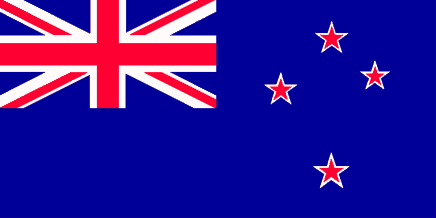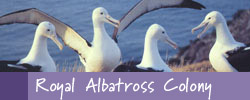
13 December 2002
It's
a bright and sunny day. The sky is blue and the sun is out.![]() .
After breakfast we take a look at the University of Otago
.
After breakfast we take a look at the University of Otago.
It
is a large complex spanning several blocks. Around it are residential streets
with rundown wooden low rise houses, rented out as flats for students . The
University building itself with the clock tower is reportedly the most
photographed building in town.
There is a lot of graduating going on, judging by the number of
students in robes, escorted by their family.
We drive to Baldwin St, the steepest street in the world with a
gradient of 38%. Then we set out to leave town and drive to
the Otago peninsula, a beautiful peninsula
close to Dunedin. We take the Highcliff
Road, which follows the ridge in the middle of the peninsula, offering fine
views of both Dunedin's harbour and the Pacific Ocean. We arrive at Larnach
Castle. It is the only "castle" of New Zealand.
In fact it is a folly of a stately home, built at enormous expense with
materials from all over the world for an british banker, William Larnach, who
made his fortune here towards the end of the 19th century. Construction
began in 1871 and took 5 years. The castle fell into disrepair until it was
bought by the Barker family who took it upon themselves to restore it to its
former glory. It is now open to the public. It is worth a visit, if only for the
beautiful views from the tower.
We
have lunch there before we move on further up the peninsula. After a magnificent
drive we arrive at Penguin Place.
Here we can, accompanied by a guide, get a close range look at nesting Yellow
Eyed Penguins or Hoiho's and Little Blue Penguins. We can approach them by means
of a system of tunnels and trenches, staying out of birds' sight. The visit does
not come cheap (NZ$25 for 1.5 hours), but it helps paying towards the costs
involved in protecting the animals in this environment.
Penguin
Place has already earned a number of prizes in the field of eco-tourism. The birds are given a hand in their survival because the land owner, Howard
McGrowther, hunts at introduced predators like ferrets, stoats, possums, cats
and dogs. He also built tiny shelters under which the penguins do their nesting,
thus replacing the role of natural vegetation that has disappeared because of
logging and sheep farming. The Yellow Eyed Penguin is the rarest breed (5,000 à
6,000 animals in the world) and also a very special kind of penguin. It does not
live in groups, but solitary and only meets up with its partner to breed. The
chick is fed - even at the cost of the parents well being - until it is grown,
but it is not taught how to survive. It has to find out for itself, which - in
many cases - it fails to do. The yellow eyed does not accept food it has not
caught itself. This is why this breed of penguin cannot be tamed or kept in a
zoo. Tours leave every half hour.
After
that we drive to the peninsula's headland. Here we find a
colony of Royal Albatross.
Tours leave every hour ($25), which we join of course. After an introductory
film we can go to the observation hut to look at the magnificent birds while
they are breeding or graciously flying about the coast. The animals are very
tall: 1 metre (over 3 ft) long and their wingspan is about 3 metres (10 ft). The
albatross too, are given a hand every now and then. Predators are hunted down,
the nests are being protected, orphans are force fed or given into care with
childless pairs of Albatross. The birds are ringed, weighed and monitored.  We are lucky to see 5 or 6 albatross playfully flying around the headland and
get a good impression of the big birds. A special kind of bird they are too. Our
enthusiatic guide tells all kinds of things about the Royal Albatross. They grow
very old (over 60 yrs) and spend two thirds of their life at sea, without
setting foot on land for years. The first three years of their independent life
is spent roaming the southern oceans. After that they return to their birth
ground to mate. They mate for life. After raising a chick the birds fly out
separately only to return after a year within hours of each other! The birds lay
their egg in November and we are are now in the middle of the 11 week breeding
season. In total it takes the bird a year to breed and raise the
chick.
We are lucky to see 5 or 6 albatross playfully flying around the headland and
get a good impression of the big birds. A special kind of bird they are too. Our
enthusiatic guide tells all kinds of things about the Royal Albatross. They grow
very old (over 60 yrs) and spend two thirds of their life at sea, without
setting foot on land for years. The first three years of their independent life
is spent roaming the southern oceans. After that they return to their birth
ground to mate. They mate for life. After raising a chick the birds fly out
separately only to return after a year within hours of each other! The birds lay
their egg in November and we are are now in the middle of the 11 week breeding
season. In total it takes the bird a year to breed and raise the
chick.
Besides
of the albatross it is also possible to visit
FortTaiaroa (a fortress from Wold War II), but we do not bother
with that.
We drive back to Dunedin. Meanwhile it has started to rain quite
heavily. At night we eat at a Thai café.
14 December 2002
Today we have again a very sunny start to the day. We leave the
Albatross Inn after breakfast and drive in a Northerly direction to
Christchurch. That is quite a drive. On our way up we stop
to have a look at the Mouraki Boulders. This a group of boulders on the beach at
Mouraki. The water has polished them troughout the centuries. Some of them are 2
metres (6 ft) in diameter. The boulders did not fall from the sky, but were
originally packed into the rocks that have subsequently been washed away by the
sea. The boulders were created some 60 million years ago around calcium
carbonate crystals. There used to be a lot more boulders but some of them have
been removed by human hands. Left are the boulders that were to heavy to move.
Access to the beach is over private property (of a restaurant) and non-guests
are supposed to drop NZ$2 in the honesty-box.
We have lunch in Timaru. The drive that follows
through the Canterbury Plains is very boring. Endless ![]() plains
of meadows and the snow tipped mountain disappear further and further in the
distance. Around 3pm we arrive in Christchurch. We
stay at Dorothy's a good and upmarket (gay) B&B,
they call a Boutique Hotel down
here. We are greeted very warmly by Tony en Sam who escort us to our
over-decorated room full of bric a brac and furniture. The decoration follows a
plains
of meadows and the snow tipped mountain disappear further and further in the
distance. Around 3pm we arrive in Christchurch. We
stay at Dorothy's a good and upmarket (gay) B&B,
they call a Boutique Hotel down
here. We are greeted very warmly by Tony en Sam who escort us to our
over-decorated room full of bric a brac and furniture. The decoration follows a
Wizard of Oz theme and there
is no lack of references to Dorothy and Judy Garland. Even the crockery is
decorated with little red shoes!
Later in the afternoon we take a ride on the historic tram,
that makes a short loop through the historic district of the city. The city
shows a lot of english influences from the days of its early development in the
second half of the 19th century. There are lots of activities in the streets and
there is an animated atmosphere.
After the ride we have a drink and do some e-mailing home before we
return to Dorothy's. At night we have dinner in Dorothy's Rainbow Restaurant
that runs the same Wizard of Oz theme. The food and the wine are excellent.
After
dinner we go to the Chameleon's Bar the only gay bar we are able to find. It is a busy
place, with a happy atmosphere. We are treated to a christmass drag show.
15 December 2002
After
a tasteful
breakfast
we walk into town. We have coffee at Starbucks and do a tour with a Punt. This
is a sort of gondola navigated by a punter - in our case an attractive student -
on the river Avon, while we are taking in the views. Very English. Are we in
Cambridge?
After the short ride (20 min. NZ$12 pp) we take
the car to Akaroa on the Banks peninsula.
The drive takes us through beautiful mountain scenery with
breathtaking views of the Akaroa Harbour. Akaroa is about 75
km (47 mi) from Christchurch. It once was a French settlement founded in 1838,
but almost instantly taken by the British, making it the first official British
colony in New Zealand, consisting of 63 Frenchmen and 6 Germans! We have lunch
here with a harbour view at L' Hotel. The street names are French and some of
buildings are in a French colonial style. But that is as French as it gets. The
tourist industry, however, does its best to conjure up a French atmosphere
nevertheless.
At
night we eat from a Chinese (buffet) at Chung Wa.
16 December 2002
After breakfast we stroll into town. It is a sunny day. We drink
coffee outside at Starbucks and explore the shopping streets We have lunch in
one of the shopping malls and try to fill our time with shopping, people
watching and enjoying the sun. We sit down for a drink every now and then, for
instance in
New Regent Street. This is one of Christchurch's most attractive streets. The
houses are painted in pastel colours and built in a Spanish Mission style,
popular in 18th century California and New Mexico. Around 3pm we are back at
Dorothy's to pick up our suitcases and the car. At around 5.30pm we fly with Air
New Zealand to Auckland International Airport,
where we have to change planes. Before we do that we have to pay a departure tax
of NZ$ 22. We do some Tax Free shopping. Our flight NZ2 leaves at 9.45pm. After 12
hours we land for a short stop in Los Angeles. Again we have to follow the
futile procedure of going through immigration, filling out a form and receiving
a stamp in our passports before we can return to the departure lounge to wait
for the remainder of our journey. After a two hour wait we continue to London
Heathrow. In London we arrive with some delay. We have to transfer from terminal
3 to terminal 1 and wait 3 hours for our final flight to Amsterdam. We are in
Amsterdam before we know it and to our surpise our baggage is the first to come
off the belt after we checked them in 30 hours and three flights earlier in Christchurch!
We have lost our bagage on much simpler journeys, but this is superb. Our train
to Rotterdam leaves within minutes from the time we get to the railway station .
After more than 36 hours after we left our hotel in Christchurch we are finally home again. End of a wonderful trip.